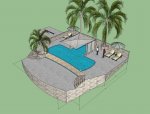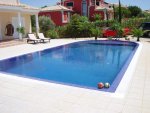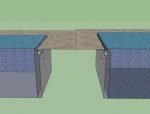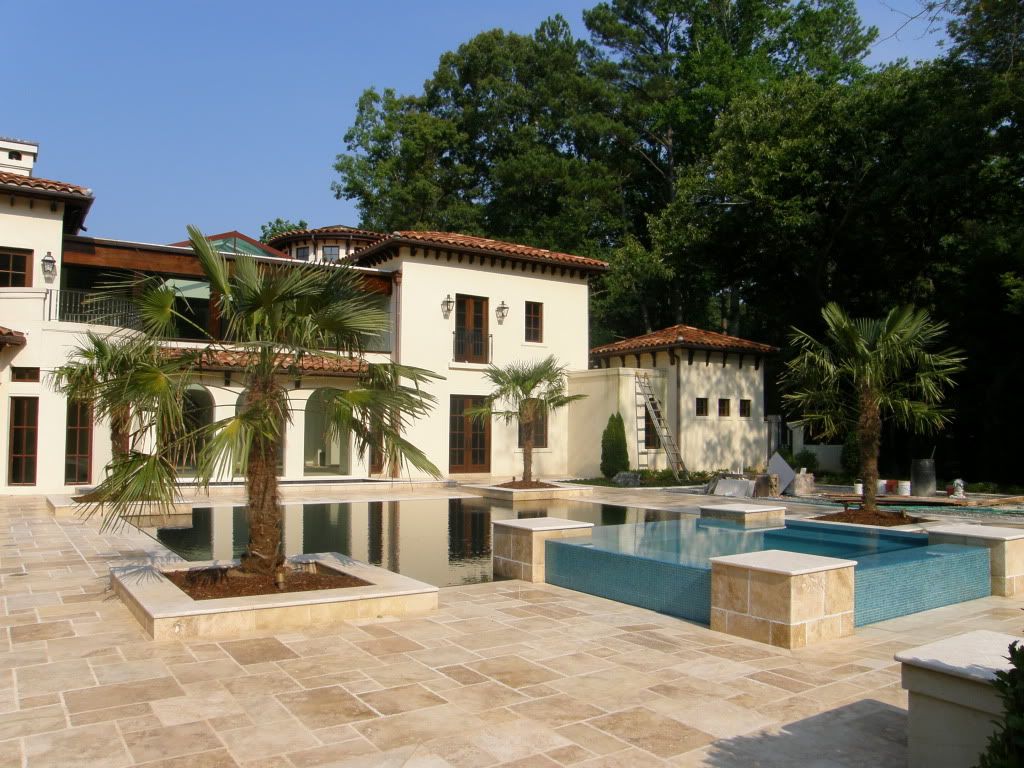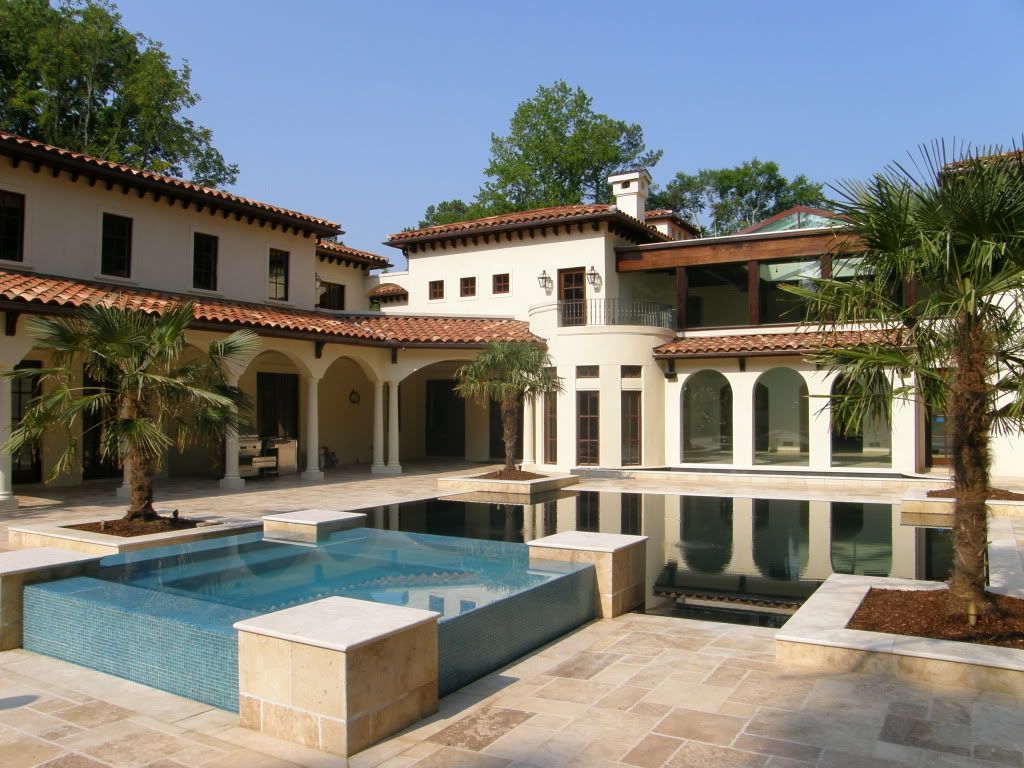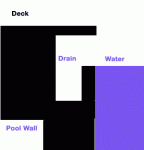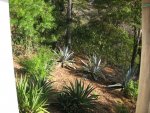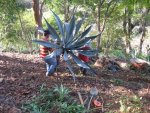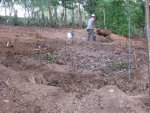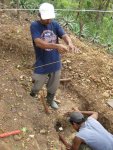NOTE: It's been three years since my original postings outlining our plans for a swimming pool. The pool is finished and since we now have an internet link at home I can upload photos and captions of the build. Posts 1 through 19 are from three years ago that set the ball rolling. The build posts start at #20. I'll be adding photos and captions in blocks of 5 (max permitted?) as time permits. The information available on TFP has been very helpful in completing the project. Thanks to all.
New Design:

Original Post from 3 years ago.
Luckily, I came across this forum late last year. My wife and I had made the decision to install a pool but we put on the brakes as the information we were getting from builders simply didn't correspond (to a worrisome degree) with the wealth of information and advice on this site. Having made it through a busy Christmas and New Year holiday season we are starting up again, this time as a DIY project.
We live in (have retired to) Nicaragua (from Canada) and as such the resources (materials, products, trades, services, processes) common in the US and Canada are either not available or come at a considerably higher cost. A pool in Nicaragua is considered an extreme luxury and builders charge accordingly--thus our DIY effort. Although familiar (and hands-on) with construction in general (houses, boats, rain water cisterns), this is the first time for a pool and I would welcome your comments, ideas and suggestions along the way.
As important as work is in Nicaragua, there is always time for friends, family and fiesta. Although it was right for us to leave the hustle and bustle of our lives behind, it is with a certain envy that I read about (some) pools being layed out day 1, dug day 2, steel/pluming installed day 3 (maybe 4), and gunited by the end of the week - mas o menos. In Nicaragua, things get done "poco a poco" (little by little). I'm looking at an 8-12 month build, hopefully. Hang in with me, we'll get there.
My apologies for the length of this initial post. Getting the shell built is going to be my single biggest challenge mostly due to the limited resources I have to work with. Rather than have members make suggestions along paths not possible I thought it best to lay out a few key boundaries for this build. Comments, suggestions and ideas welcome at any point. If in reading through any of this and a detail has been covered in another post that you know about, please direct me to that post if it's more convenient.
A few details about the pool:
T-shaped 12x32x5 with a the T stub being 10x10x1.5; approx 16,500 gal. For: water games, swim some laps, a shallow lounging area. The depth would slope down from both ends of the T (approx. 4.5 ft) to a center depth of 5.5 ft. A canopy over the T's stub to allow use in the rather brutal mid-day sun. A key feature is a total perimeter wet edge (always one for jumping into the deep end first, so to speak).
Given the resources available in this part of the planet, the best construction options available to me (i.e. known at the moment) are:
1) cement block - mortared with re-bar and concrete in the cavities; covered with a regular cementitious parging (other suggestions for a parging/primary waterproofing particularly welcome here); with either a tile finish (glass, vitreous, porcelain) or vinyl liner (parging/waterproofing not necessary?).
2) cement block - dry stacked with concrete in the cavities; covered with a surface bonding (fibrated) cement; with either a tile finish (glass, vitreous, porcelain) or vinyl liner.
3) ferrocement - with either a tile finish (glass, vitreous, porcelain) or vinyl liner. pool250 has a great thread running on this construction method.
Gunite, shotcrete, poured concrete walls (floor OK) and fiberglass are not an option, economically and in terms of available skills. Plaster finishes as well as the Pebble-Tec type finishes are not an option either.
I've seen duraleigh's thread (http://www.troublefreepool.com/an-unusual-pool-build-t10597.html) corresponding to option 1, with a vinyl liner. Thanks to all who contributed and a very workable solution for my build, except for the not so itty-bitty detail of the wet edge (see below). Also, an issue that I'm facing is that although most "masons" can parge (repello) very well, they can't butter and set a block (or brick) to save their lives. There is an incredible waste of mortar and most of it ends up at the bottom of the cavity so that when a concrete in-fill is added, it beds on a crumbly, popcorn base of old mortar at the bottom of the cavity and with all sorts of blobs squishing out from the joints between blocks in the cavity column (making for a very poor and "cold" wall/floor joint). Now that I think of it, I suppose the bottom row of blocks could have clean-outs (like besser blocks -pdf link, possible slow download http://www.adbrimasonry.com.au/lib/pdf/Brochure/mf1113.pdf) and except for the wastage (which could be recycled on the fly) may make for a more workable approach.
Option 2 seems very interesting. Dry stacking is very well suited to DIYers and with a surface bonding cement parging apparently, from what I've read, provides a considerably stronger wall than mortared block construction. It also gets around the problem of sloppy mortar joints mentioned for option 1, above. If anyone has experience with or can comment on this type of construction I'd love to hear from you.
Likewise, pool250's build (http://www.troublefreepool.com/my-self-build-ferrocement-pool-t28358.html) has great potential for my build as well, especially if I can confirm that the "ferro-panel" that I used in the construction of my house is also suitable for pool construction. I'm checking that out on several fronts now but other comments/suggestions from members would be most welcome too.
The not so itty-bitty detail:
I'd really like to do a full perimeter wet edge pool. For two reasons: 1) the aesthetics; 2) keeping it clean. The latter is perhaps the most important. Wind, blowing dust and dirt, leaves, pollen, seeds, flower petals, bugs are an issue 365 days a year. The winds are particularly strong at the time of year that trees and plants are shedding and then again blooming. Without exception, every pool I have seen has a problem with debris swirling around in back eddies (and sinking to the bottom) on the leeward side of pool walls regardless of where skimmers are placed. My thought is that with a perimeter wet edge there is nothing for debris to get hung up on. Furthermore, by placing the returns in the bottom of the pool so that incoming water wells up and flows over the edges, the accumulation of debris could be further reduced.(if I'm wrong on this please let me know). I have also read that returns on the bottom circulate the water better in terms of keeping the water temperature warmer. Interestingly, between the cooling effects of evaporation and chilly nights, pools in the tropics can be uncomfortably cool for a lot of people. Although I have browsed through the material in "Pool School" and "Hydraulics 101" and have a sense of where I'm going, comments and suggestions on the hydraulics of this build would be greatly appreciated. (or is this perhaps better suited in the "Pumping Station" forum?)
The attached plan (using Sketchup) is just a conceptual drawing and a general idea of what the pool will look like. The freewall edge is not meant to be a cascade, and maybe not even a wet wall; instead having a gutter much like the rest of the perimeter (I have some ideas about gutters, but others are welcome). The walls are curved because I was anticipating the use of a ferrocement-like construction and curved/arched surfaces contribute greatly to strength (eg. Hoover Dam). This would probably be helpful with cement block as well.
Regarding vinyl liners--can they be attached below the surface? Vinyl liner pools that have fiberglass swimouts and steps cut into the sides, are the liners attached underwater along the edge of the cutout? I also came across a reference (and am trying to find out more) about a Tommy Johnson of Johnson Pool and Spa (Huntsville, AL?) building a perimeter wet edge vinyl lined pool. Are there any issues/problems/tips that I should be aware of using liners in this configuration, if they can be used at all?
Thanks for dropping by.
New Design:

Original Post from 3 years ago.
Luckily, I came across this forum late last year. My wife and I had made the decision to install a pool but we put on the brakes as the information we were getting from builders simply didn't correspond (to a worrisome degree) with the wealth of information and advice on this site. Having made it through a busy Christmas and New Year holiday season we are starting up again, this time as a DIY project.
We live in (have retired to) Nicaragua (from Canada) and as such the resources (materials, products, trades, services, processes) common in the US and Canada are either not available or come at a considerably higher cost. A pool in Nicaragua is considered an extreme luxury and builders charge accordingly--thus our DIY effort. Although familiar (and hands-on) with construction in general (houses, boats, rain water cisterns), this is the first time for a pool and I would welcome your comments, ideas and suggestions along the way.
As important as work is in Nicaragua, there is always time for friends, family and fiesta. Although it was right for us to leave the hustle and bustle of our lives behind, it is with a certain envy that I read about (some) pools being layed out day 1, dug day 2, steel/pluming installed day 3 (maybe 4), and gunited by the end of the week - mas o menos. In Nicaragua, things get done "poco a poco" (little by little). I'm looking at an 8-12 month build, hopefully. Hang in with me, we'll get there.
My apologies for the length of this initial post. Getting the shell built is going to be my single biggest challenge mostly due to the limited resources I have to work with. Rather than have members make suggestions along paths not possible I thought it best to lay out a few key boundaries for this build. Comments, suggestions and ideas welcome at any point. If in reading through any of this and a detail has been covered in another post that you know about, please direct me to that post if it's more convenient.
A few details about the pool:
T-shaped 12x32x5 with a the T stub being 10x10x1.5; approx 16,500 gal. For: water games, swim some laps, a shallow lounging area. The depth would slope down from both ends of the T (approx. 4.5 ft) to a center depth of 5.5 ft. A canopy over the T's stub to allow use in the rather brutal mid-day sun. A key feature is a total perimeter wet edge (always one for jumping into the deep end first, so to speak).
Given the resources available in this part of the planet, the best construction options available to me (i.e. known at the moment) are:
1) cement block - mortared with re-bar and concrete in the cavities; covered with a regular cementitious parging (other suggestions for a parging/primary waterproofing particularly welcome here); with either a tile finish (glass, vitreous, porcelain) or vinyl liner (parging/waterproofing not necessary?).
2) cement block - dry stacked with concrete in the cavities; covered with a surface bonding (fibrated) cement; with either a tile finish (glass, vitreous, porcelain) or vinyl liner.
3) ferrocement - with either a tile finish (glass, vitreous, porcelain) or vinyl liner. pool250 has a great thread running on this construction method.
Gunite, shotcrete, poured concrete walls (floor OK) and fiberglass are not an option, economically and in terms of available skills. Plaster finishes as well as the Pebble-Tec type finishes are not an option either.
I've seen duraleigh's thread (http://www.troublefreepool.com/an-unusual-pool-build-t10597.html) corresponding to option 1, with a vinyl liner. Thanks to all who contributed and a very workable solution for my build, except for the not so itty-bitty detail of the wet edge (see below). Also, an issue that I'm facing is that although most "masons" can parge (repello) very well, they can't butter and set a block (or brick) to save their lives. There is an incredible waste of mortar and most of it ends up at the bottom of the cavity so that when a concrete in-fill is added, it beds on a crumbly, popcorn base of old mortar at the bottom of the cavity and with all sorts of blobs squishing out from the joints between blocks in the cavity column (making for a very poor and "cold" wall/floor joint). Now that I think of it, I suppose the bottom row of blocks could have clean-outs (like besser blocks -pdf link, possible slow download http://www.adbrimasonry.com.au/lib/pdf/Brochure/mf1113.pdf) and except for the wastage (which could be recycled on the fly) may make for a more workable approach.
Option 2 seems very interesting. Dry stacking is very well suited to DIYers and with a surface bonding cement parging apparently, from what I've read, provides a considerably stronger wall than mortared block construction. It also gets around the problem of sloppy mortar joints mentioned for option 1, above. If anyone has experience with or can comment on this type of construction I'd love to hear from you.
Likewise, pool250's build (http://www.troublefreepool.com/my-self-build-ferrocement-pool-t28358.html) has great potential for my build as well, especially if I can confirm that the "ferro-panel" that I used in the construction of my house is also suitable for pool construction. I'm checking that out on several fronts now but other comments/suggestions from members would be most welcome too.
The not so itty-bitty detail:
I'd really like to do a full perimeter wet edge pool. For two reasons: 1) the aesthetics; 2) keeping it clean. The latter is perhaps the most important. Wind, blowing dust and dirt, leaves, pollen, seeds, flower petals, bugs are an issue 365 days a year. The winds are particularly strong at the time of year that trees and plants are shedding and then again blooming. Without exception, every pool I have seen has a problem with debris swirling around in back eddies (and sinking to the bottom) on the leeward side of pool walls regardless of where skimmers are placed. My thought is that with a perimeter wet edge there is nothing for debris to get hung up on. Furthermore, by placing the returns in the bottom of the pool so that incoming water wells up and flows over the edges, the accumulation of debris could be further reduced.(if I'm wrong on this please let me know). I have also read that returns on the bottom circulate the water better in terms of keeping the water temperature warmer. Interestingly, between the cooling effects of evaporation and chilly nights, pools in the tropics can be uncomfortably cool for a lot of people. Although I have browsed through the material in "Pool School" and "Hydraulics 101" and have a sense of where I'm going, comments and suggestions on the hydraulics of this build would be greatly appreciated. (or is this perhaps better suited in the "Pumping Station" forum?)
The attached plan (using Sketchup) is just a conceptual drawing and a general idea of what the pool will look like. The freewall edge is not meant to be a cascade, and maybe not even a wet wall; instead having a gutter much like the rest of the perimeter (I have some ideas about gutters, but others are welcome). The walls are curved because I was anticipating the use of a ferrocement-like construction and curved/arched surfaces contribute greatly to strength (eg. Hoover Dam). This would probably be helpful with cement block as well.
Regarding vinyl liners--can they be attached below the surface? Vinyl liner pools that have fiberglass swimouts and steps cut into the sides, are the liners attached underwater along the edge of the cutout? I also came across a reference (and am trying to find out more) about a Tommy Johnson of Johnson Pool and Spa (Huntsville, AL?) building a perimeter wet edge vinyl lined pool. Are there any issues/problems/tips that I should be aware of using liners in this configuration, if they can be used at all?
Thanks for dropping by.
Attachments
Last edited by a moderator:


